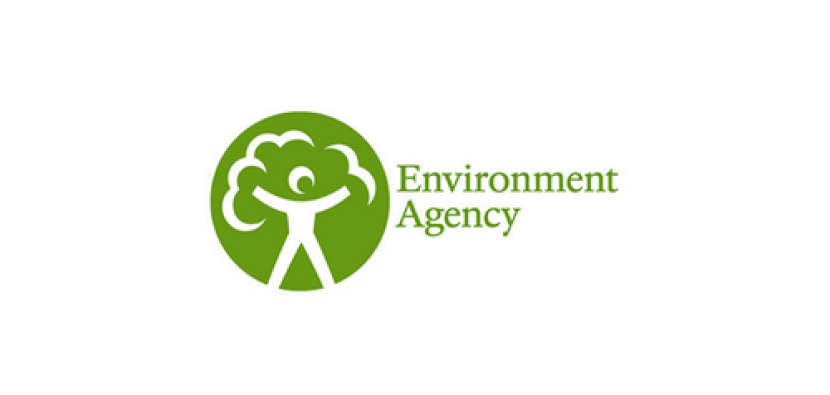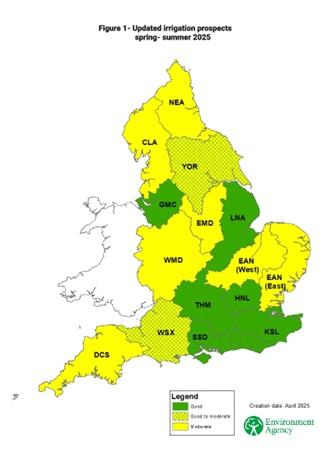
Updated prospects for irrigation – Area forecasts for 2025
April 2025 Updated prospects for irrigation - forecast for 2025 from the Environment Agency
- see the full forecast document in the PDF above
Summary
"Our updated prospects for irrigation across England for 2025 is Good to Moderate. This has been downgraded from Good in February’s initial prospects report due to below average rainfall at the end of February, March and April across many parts of England.
We encourage irrigators to take action now to safeguard supplies for the summer, especially those in areas classed as moderate."
Possible actions include:
- Talk to the Environment Agency and NFU to discuss options and possible risks this summer
- Check all pipes and pumps are working correctly – fix any leaks
- You should be especially rigorous about irrigation scheduling and ensuring that your equipment is set up properly to apply no more water than the crop needs
- Consider applying for a Local Resource Option screening study with growers in your area to improve drought resilience. More information can be found in our full area irrigation report.
- Talk to the Environment Agency to discuss whether you can take water outside your licence during high flows. There is a Regulatory Position Statement for abstracting water outside of licence conditions in place to support abstractors.
- Review your licences to ensure you comply with your conditions.
The irrigation prospects reflect the water situation using current river flows, groundwater conditions, latest available weather forecasts and Met Office seasonal outlooks.

It was the driest March across England since 1961 with only 22% of the long-term average rainfall (LTA) recorded. April has been another dry month across most of England which has received half the LTA rainfall. However, there has been some regional variations, with southwest England receiving above average rainfall and the northeast less than one fifth.
Following the predominantly dry weather, over half of rivers are classed as below normal with some exceptionally low in northern England for the time of year. In contrast, rivers in southwest and southern England which are supported by groundwater, are normal for the time of year. Soils are very dry for the time of year particularly across northern England.
Groundwater levels responded well to the wet weather during autumn and the early part of winter, although the dry weather over spring has brought an early end on the groundwater recharge season. At the end of March, groundwater in the chalk and sandstone across England generally ranged from normal or above for the time of year, with the exception of the faster responding limestone aquifers which have dropped off rapidly, with one site now exceptionally low for the time of year in the Cotswolds.
Most farm irrigation reservoirs are healthy but there has been an early start to the irrigation season this year. Should the dry weather continue, there is likely to be an increased demand on irrigation storage reservoirs later in the summer. We are advising farmers to monitor their reservoirs in case it remains dry through the rest of spring and into the summer.
Into May, weather conditions are likely to stay predominately dry and settled. Changeable conditions are likely during the second half of May with spells of wetter weather interspersed with drier spells.
More information on weather forecasts is available at the Met Office
More information on the water situation is available at Water situation reports for England - GOV.UK (www.gov.uk).
Prospects for individual areas
| Area | Prospects for 2025 |
| Environment Agency Cumbria and Lancashire | Moderate |
| Environment Agency Devon, Cornwall and the Isles of Scilly | Moderate |
| Environment Agency East Anglia East (covering Essex Norfolk and Suffolk) | Moderate |
| Environment Agency East Anglia West (covering Cambridgeshire and Bedfordshire) | Moderate |
| Environment Agency East Midlands | Moderate |
| Environment Agency Greater Manchester, Merseyside and Cheshire | Good |
| Environment Agency Hertfordshire and North London | Good |
| Environment Agency Kent, South London and East Sussex | Good |
| Environment Agency Lincolnshire and Northamptonshire | Good |
| Environment Agency North East | Moderate |
| Environment Agency Solent and South Downs | Good |
| Environment Agency Thames | Good |
| Environment Agency Wessex | Good to Moderate |
| Environment Agency West Midlands | Moderate |
| Environment Agency Yorkshire | Good to Moderate |
Definitions
Prospects for spray irrigation are defined as ‘Good’, ‘Moderate’ or ‘Poor’.
| Good | Water levels are average or above average and supplies are expected to be safe. There is a possibility of minor local controls on abstraction from surface water in late summer if the weather is exceptionally hot and dry. |
| Moderate | Water levels are low. Some controls on surface water abstraction are possible by midsummer if the weather is hot and dry. Controls on abstraction from groundwater are possible in small, sensitive groundwater areas. |
| Poor | Water levels are well below average. Soil moisture deficit is developing early and significant restrictions on abstraction from surface and groundwater are probable. |